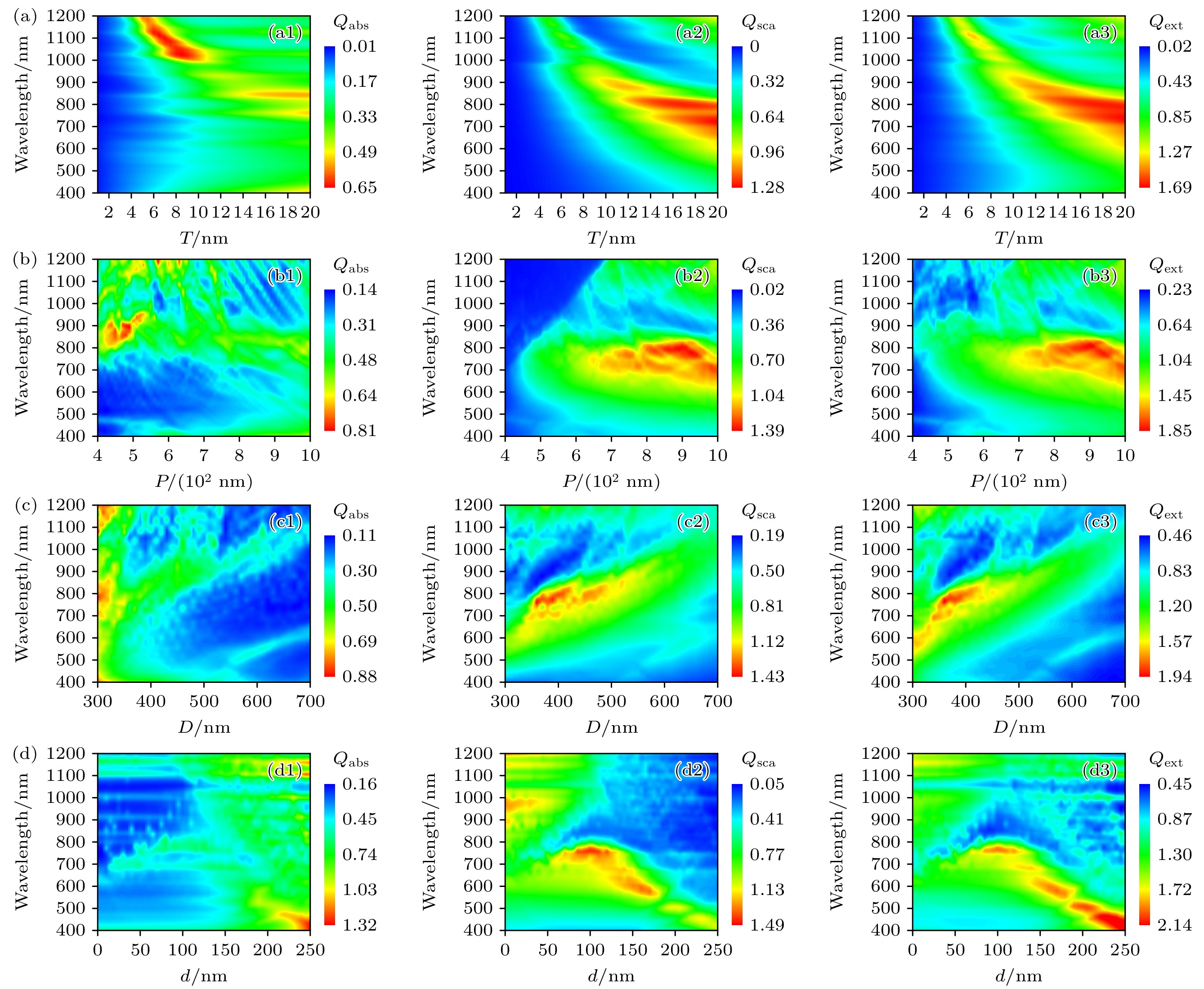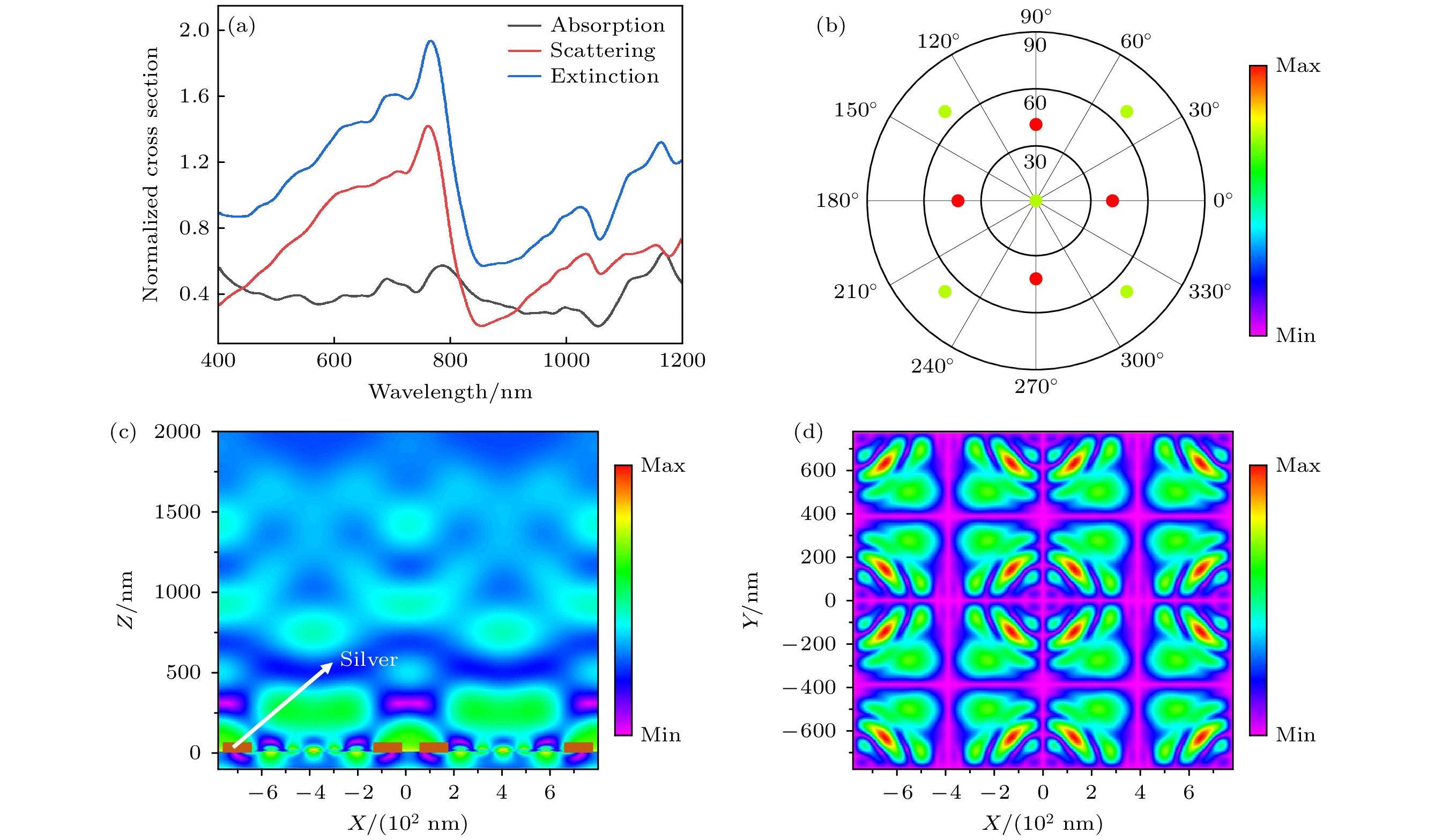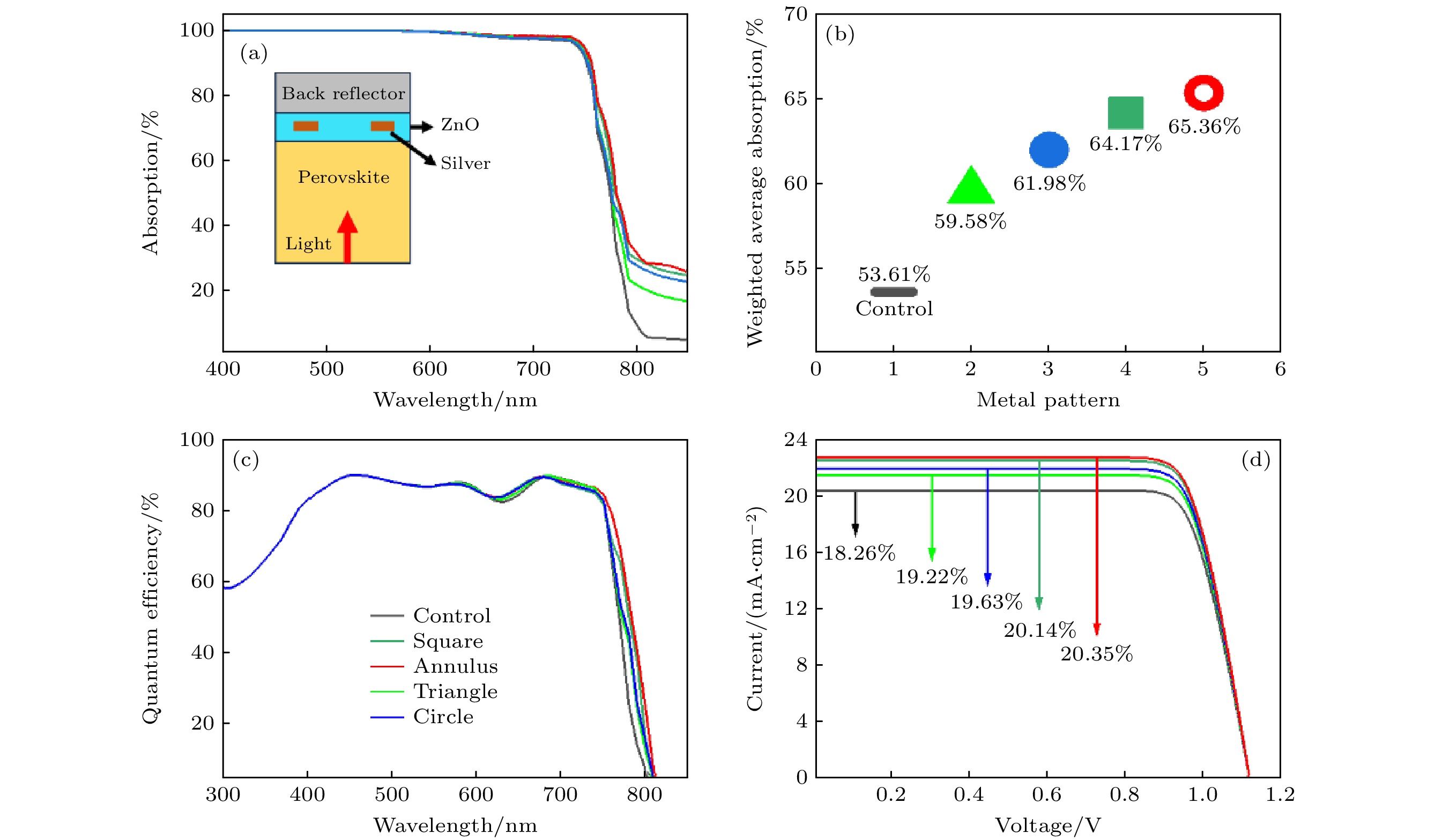-
The integration of metallic nanoparticles (MNPs) with plasmonic effects is an alternative approach to managing photons and charge carriers, and is considered as a promising method of advancing solar cell technologies. Plasmonic-enhanced solar energy harvesting involves three mechanisms: hot-electron injection, light trapping, and modulation of energy flow direction through dipole-dipole coupling. It has been observed that these phenomena significantly improve the performance of silicon, gallium arsenide, dye-sensitized, and organic solar cells. However, for emerging perovskite solar cells, the light trapping effect, specifically, through the far-field scattering of MNPs, has been seldom reported. The anomalous phenomenon is primarily attributed to the size constraints imposed on MNP by the thickness of the functional layers in cell devices. According to the theory of localized surface plasmon resonance (SPR), the characteristic size of the MNP needs to be larger than 90 nm to achieve optimal photon scattering. Conversely, the charge transport layers such as NiOx and SnO2 in perovskite solar cells are usually very thin, with thickness ranging from a few nanometers to several tens of nanometers. Therefore, the community of perovskite solar cells still faces a great challenge in harvesting light through plasmonic scattering. Comparing with MNPs, none of the shape, size, periodicity, and other characteristic parameters of two-dimensional metal patterns within the horizontal plane are not limited by the thickness of the device’s functional layer, thus making it more flexible to regulate the SPR response band, vibration intensity, and becoming a method of dissipating plasmonic energy. In this work, based on the finite-difference time-domain (FDTD) method and rigorous coupled-wave analysis (RCWA), we systematically investigate the SPR spectra of different metal patterns. The results demonstrate that by optimizing characteristic parameters such as pattern shape, thickness, and periodicity, a significant SPR phenomenon can be observed in the near-infrared region, with scattering dominating extinction. For the optimal metal ring pattern, the SPR peak corresponds to a wavelength of 772 nm, with the cross-section of relative absorption, scattering, and extinction being 0.54, 1.39, and 1.93, respectively. The weighted average absorption of the perovskite response layer in a range of 700–850 nm increases from 53.61% to 65.36%. Correspondingly, the photocurrent density of the device increases from 20.39 to 22.72 mA/cm2, and the photoelectric conversion efficiency is relatively improved by 11.45%. This research provides a novel path for designing light trapping in perovskite solar cells in the near-infrared region, and serves as a “spectrum-based” reference for SPR regulation in other similar devices. [1] Huang Z Q, Li L, Wu T Q, Xue T Y, Sun W, Pan Q, Wang H D, Xie H F, Chi J M, Han T, Hu X T, Su M, Chen Y W, Song Y L 2023 Nat. Commun. 14 1204
 Google Scholar
Google Scholar
[2] 姚美灵, 廖纪星, 逯好峰, 黄强, 崔艳峰 2024 物理学报 8 088801
 Google Scholar
Google Scholar
Yao M L, Liao J X, Lu H F, Huang Q, Cui Y F 2024 Acta Phys. Sin. 8 088801
 Google Scholar
Google Scholar
[3] Zhu H, Teale S, Lintangpradipto M N, Mahesh S, Chen B, McGehee M D, Sargent E H, Bakr O M 2023 Nat. Rev. Mater. 8 569
 Google Scholar
Google Scholar
[4] Raza H, Imran T, Gao Y, Azeem M, Younis M, Wang J N, Liu S W, Yang Z C, Liu Z H, Chen W 2024 Energ. Environ. Sci. 17 1819
 Google Scholar
Google Scholar
[5] Green M A, Dunlop E D, Yoshita M, Kopidakis N, Bothe K, Siefer G, Hao X 2023 Prog. Photovoltaics 31 651
 Google Scholar
Google Scholar
[6] The National Renewable Energy Laboratory (NREL) 2024 https://www.nrel.gov/pv/cell-efficiency.html/
[7] 崔兴华, 许巧静, 石标, 侯福华, 赵颖, 张晓丹 2020 物理学报 69 207401
 Google Scholar
Google Scholar
Cui X H, Xu Q J, Shi B, Hou F H, Zhao Y, Zhang X D 2020 Acta Phys. Sin. 69 207401
 Google Scholar
Google Scholar
[8] Park J, Kim J, Yun H, Paik M J, Noh E, Mun H J, Kim M G, Shin T J, Seok S I 2023 Nature 616 724
 Google Scholar
Google Scholar
[9] Chen R, Liu S W, Xu X J, Ren F M, Zhou J, Tian X Y, Yang Z C, Guanz X Y, Liu Z H, Zhang S S, Zhang Y Q, Wu Y Z, Han L Y, Qi Y B, Chen W 2022 Energ. Environ. Sci. 15 2567
 Google Scholar
Google Scholar
[10] Shen X Q, Lin X S, Peng Y, Zhang Y Q, Long F, Han Q F, Wang Y B, Han L Y 2024 Nano-Micro Lett. 16 201
 Google Scholar
Google Scholar
[11] Zhang S F, Ye F, Wang X Y, Chen R, Zhang H D, Zhan L Q, Jiang X Y, Li Y W, Ji X Y, Liu S J, Yu M J, Yu F R, Zhang Y L, Wu R H, Liu Z H, Ning Z J, Neher D, Han L Y, Lin Y Z, Tian H, Chen W, Stolterfoht M, Zhang L J, Zhu W H, Wu Y Z 2023 Science 380 404
 Google Scholar
Google Scholar
[12] Huang Y M, Wu Y Z, Xu X L, Qin F F, Zhang S H, An J K, Wang H J, Liu L 2022 Chin. Phys. B 31 128802
 Google Scholar
Google Scholar
[13] 赵颂, 周华, 王淑英, 韩非, 蒋斯涵, 沈向前 2022 物理学报 71 038801
 Google Scholar
Google Scholar
Zhao S, Zhou H, Wang S Y, Han F, Jiang S H, Shen X Q 2022 Acta Phys. Sin. 71 038801
 Google Scholar
Google Scholar
[14] Berry F, Mermet Lyaudoz R, Cuevas Davila J M, Djemmah D A, Nguyen H S, Seassal C, Fourmond E, Chevalier C, Amara M, Drouard E 2022 Adv. Energy Mater. 12 2200505
 Google Scholar
Google Scholar
[15] Moakhar S R, Gholipour S, Masudy-Panah S, Seza A, Mehdikhani A, Riahi-Noori N, Tafazoli S, Timasi N, Lim Y F, Saliba M 2020 Adv. Sci. 7 1902448
 Google Scholar
Google Scholar
[16] Li Y F, Kou Z L, Feng J, Sun H B 2020 Nanophotonics-Berlin 9 3111
 Google Scholar
Google Scholar
[17] Yan G D, Zhang Z H, Guo H, Chen J P, Jiang Q S, Cui Q N, Shi Z L, Xu C X 2023 Chin. Phys. B 32 067302
 Google Scholar
Google Scholar
[18] Atwater H A, Polman A 2010 Nat. Mater. 9 205
 Google Scholar
Google Scholar
[19] Ueno K, Oshikiri T, Sun Q, Shi X, Misawa H 2018 Chem. Rev. 118 2955
 Google Scholar
Google Scholar
[20] Zhang W, Saliba M, Stranks S D, Sun Y, Shi X, Wiesner U, Snaith H J 2013 Nano Lett. 13 4505
 Google Scholar
Google Scholar
[21] Saliba M, Zhang W, Burlakov V M, Stranks S D, Sun Y, Ball J M, Johnston M B, Goriely A, Wiesner U, Snaith H J 2015 Adv. Funct. Mater. 25 5038
 Google Scholar
Google Scholar
[22] Yuan Z C, Wu Z W, Bai S, Xia Z H, Xu W D, Song T, Wu H H, Xu L H, Si J J, Jin Y Z, Sun B Q 2015 Adv. Energy Mater. 5 1500038
 Google Scholar
Google Scholar
[23] Cui X, Chen Y H, Zhang M, Harn Y W, Qi J B, Gao L K, Wang Z L, Huang J S, Yang Y K, Lin Z Q 2020 Energ. Environ. Sci. 13 1743
 Google Scholar
Google Scholar
[24] Yao K, Zhong H J, Liu Z L, Xiong M, Leng S F, Zhang J, Xu Y X, Wang W Y, Zhou L, Huang H T, Jen A K Y 2019 Acs Nano 13 5397
 Google Scholar
Google Scholar
[25] Li F Z, Lo T W, Deng X, Li S Q, Fan Y L, Lin F R, Cheng Y H, Zhu Z L, Lei D Y, Jen A K Y 2022 Adv. Energy Mater. 12 2200186
 Google Scholar
Google Scholar
[26] Yao K, Li S Q, Liu Z, Ying Y, Dvořák P, Fei L, Sikola T, Huang H T, Nordlander P, Jen A K Y, Lei D 2021 Light-Sci. Appl. 10 219
 Google Scholar
Google Scholar
[27] Cuce E, Cuce P M, Karakas I H, Bali T 2017 Energ. Convers. Manage. 146 205
 Google Scholar
Google Scholar
[28] Xu C Y, Hu W, Wang G, Niu L B, Elseman A M, Liao L P, Yao Y Q, Xu G B, Luo L, Liu D B, Zhou G D, Li P, Song Q L 2020 ACS Nano 14 196
 Google Scholar
Google Scholar
-
图 1 仿真模型及结构参数 (a)基于金属图案的钙钛矿电池示意图; (b)不同金属图案的形状及特征参数; (c)金属图案与光波的共振作用示意图
Figure 1. Simulation model and structural parameters: (a) Schematic diagram of a perovskite solar cell based on metal patterns; (b) shapes and characteristic parameters of different metal patterns; (c) schematic diagram of the resonance interaction between metal patterns and light waves.
图 4 金属圆环的表面等离激元共振响应特性 (a)相对吸收、散射及消光曲线; (b)光子散射角分布; (c)剖面光强分布; (d)俯视光强分布
Figure 4. SPR response characteristics of metal annulus: (a) Relative absorption, scattering, and extinction curves; (b) angular distribution of light scattered by the silver annulus; (c), (d) the spatial distribution of the electric field viewed from (c) a profile perspective and (d) a top-down perspective.
表 1 不同金属图案的最优结构参数及相应的SPR响应特性
Table 1. Optimal structural parameters and corresponding SPR response characteristics of different metallic patterns.
T/nm P/nm D/nm d/nm $ {\lambda }_{{\mathrm{m}}{\mathrm{a}}{\mathrm{x}}} $/nm Qabs Qsca Qext Square 18 900 350 — 760 0.53 1.34 1.87 Annulus 18 850 360 100 772 0.54 1.39 1.93 Triangle 20 700 480 — 778 0.31 0.82 1.13 Circle 12 780 350 — 714 0.61 1.20 1.81 -
[1] Huang Z Q, Li L, Wu T Q, Xue T Y, Sun W, Pan Q, Wang H D, Xie H F, Chi J M, Han T, Hu X T, Su M, Chen Y W, Song Y L 2023 Nat. Commun. 14 1204
 Google Scholar
Google Scholar
[2] 姚美灵, 廖纪星, 逯好峰, 黄强, 崔艳峰 2024 物理学报 8 088801
 Google Scholar
Google Scholar
Yao M L, Liao J X, Lu H F, Huang Q, Cui Y F 2024 Acta Phys. Sin. 8 088801
 Google Scholar
Google Scholar
[3] Zhu H, Teale S, Lintangpradipto M N, Mahesh S, Chen B, McGehee M D, Sargent E H, Bakr O M 2023 Nat. Rev. Mater. 8 569
 Google Scholar
Google Scholar
[4] Raza H, Imran T, Gao Y, Azeem M, Younis M, Wang J N, Liu S W, Yang Z C, Liu Z H, Chen W 2024 Energ. Environ. Sci. 17 1819
 Google Scholar
Google Scholar
[5] Green M A, Dunlop E D, Yoshita M, Kopidakis N, Bothe K, Siefer G, Hao X 2023 Prog. Photovoltaics 31 651
 Google Scholar
Google Scholar
[6] The National Renewable Energy Laboratory (NREL) 2024 https://www.nrel.gov/pv/cell-efficiency.html/
[7] 崔兴华, 许巧静, 石标, 侯福华, 赵颖, 张晓丹 2020 物理学报 69 207401
 Google Scholar
Google Scholar
Cui X H, Xu Q J, Shi B, Hou F H, Zhao Y, Zhang X D 2020 Acta Phys. Sin. 69 207401
 Google Scholar
Google Scholar
[8] Park J, Kim J, Yun H, Paik M J, Noh E, Mun H J, Kim M G, Shin T J, Seok S I 2023 Nature 616 724
 Google Scholar
Google Scholar
[9] Chen R, Liu S W, Xu X J, Ren F M, Zhou J, Tian X Y, Yang Z C, Guanz X Y, Liu Z H, Zhang S S, Zhang Y Q, Wu Y Z, Han L Y, Qi Y B, Chen W 2022 Energ. Environ. Sci. 15 2567
 Google Scholar
Google Scholar
[10] Shen X Q, Lin X S, Peng Y, Zhang Y Q, Long F, Han Q F, Wang Y B, Han L Y 2024 Nano-Micro Lett. 16 201
 Google Scholar
Google Scholar
[11] Zhang S F, Ye F, Wang X Y, Chen R, Zhang H D, Zhan L Q, Jiang X Y, Li Y W, Ji X Y, Liu S J, Yu M J, Yu F R, Zhang Y L, Wu R H, Liu Z H, Ning Z J, Neher D, Han L Y, Lin Y Z, Tian H, Chen W, Stolterfoht M, Zhang L J, Zhu W H, Wu Y Z 2023 Science 380 404
 Google Scholar
Google Scholar
[12] Huang Y M, Wu Y Z, Xu X L, Qin F F, Zhang S H, An J K, Wang H J, Liu L 2022 Chin. Phys. B 31 128802
 Google Scholar
Google Scholar
[13] 赵颂, 周华, 王淑英, 韩非, 蒋斯涵, 沈向前 2022 物理学报 71 038801
 Google Scholar
Google Scholar
Zhao S, Zhou H, Wang S Y, Han F, Jiang S H, Shen X Q 2022 Acta Phys. Sin. 71 038801
 Google Scholar
Google Scholar
[14] Berry F, Mermet Lyaudoz R, Cuevas Davila J M, Djemmah D A, Nguyen H S, Seassal C, Fourmond E, Chevalier C, Amara M, Drouard E 2022 Adv. Energy Mater. 12 2200505
 Google Scholar
Google Scholar
[15] Moakhar S R, Gholipour S, Masudy-Panah S, Seza A, Mehdikhani A, Riahi-Noori N, Tafazoli S, Timasi N, Lim Y F, Saliba M 2020 Adv. Sci. 7 1902448
 Google Scholar
Google Scholar
[16] Li Y F, Kou Z L, Feng J, Sun H B 2020 Nanophotonics-Berlin 9 3111
 Google Scholar
Google Scholar
[17] Yan G D, Zhang Z H, Guo H, Chen J P, Jiang Q S, Cui Q N, Shi Z L, Xu C X 2023 Chin. Phys. B 32 067302
 Google Scholar
Google Scholar
[18] Atwater H A, Polman A 2010 Nat. Mater. 9 205
 Google Scholar
Google Scholar
[19] Ueno K, Oshikiri T, Sun Q, Shi X, Misawa H 2018 Chem. Rev. 118 2955
 Google Scholar
Google Scholar
[20] Zhang W, Saliba M, Stranks S D, Sun Y, Shi X, Wiesner U, Snaith H J 2013 Nano Lett. 13 4505
 Google Scholar
Google Scholar
[21] Saliba M, Zhang W, Burlakov V M, Stranks S D, Sun Y, Ball J M, Johnston M B, Goriely A, Wiesner U, Snaith H J 2015 Adv. Funct. Mater. 25 5038
 Google Scholar
Google Scholar
[22] Yuan Z C, Wu Z W, Bai S, Xia Z H, Xu W D, Song T, Wu H H, Xu L H, Si J J, Jin Y Z, Sun B Q 2015 Adv. Energy Mater. 5 1500038
 Google Scholar
Google Scholar
[23] Cui X, Chen Y H, Zhang M, Harn Y W, Qi J B, Gao L K, Wang Z L, Huang J S, Yang Y K, Lin Z Q 2020 Energ. Environ. Sci. 13 1743
 Google Scholar
Google Scholar
[24] Yao K, Zhong H J, Liu Z L, Xiong M, Leng S F, Zhang J, Xu Y X, Wang W Y, Zhou L, Huang H T, Jen A K Y 2019 Acs Nano 13 5397
 Google Scholar
Google Scholar
[25] Li F Z, Lo T W, Deng X, Li S Q, Fan Y L, Lin F R, Cheng Y H, Zhu Z L, Lei D Y, Jen A K Y 2022 Adv. Energy Mater. 12 2200186
 Google Scholar
Google Scholar
[26] Yao K, Li S Q, Liu Z, Ying Y, Dvořák P, Fei L, Sikola T, Huang H T, Nordlander P, Jen A K Y, Lei D 2021 Light-Sci. Appl. 10 219
 Google Scholar
Google Scholar
[27] Cuce E, Cuce P M, Karakas I H, Bali T 2017 Energ. Convers. Manage. 146 205
 Google Scholar
Google Scholar
[28] Xu C Y, Hu W, Wang G, Niu L B, Elseman A M, Liao L P, Yao Y Q, Xu G B, Luo L, Liu D B, Zhou G D, Li P, Song Q L 2020 ACS Nano 14 196
 Google Scholar
Google Scholar
Catalog
Metrics
- Abstract views: 4506
- PDF Downloads: 166
- Cited By: 0














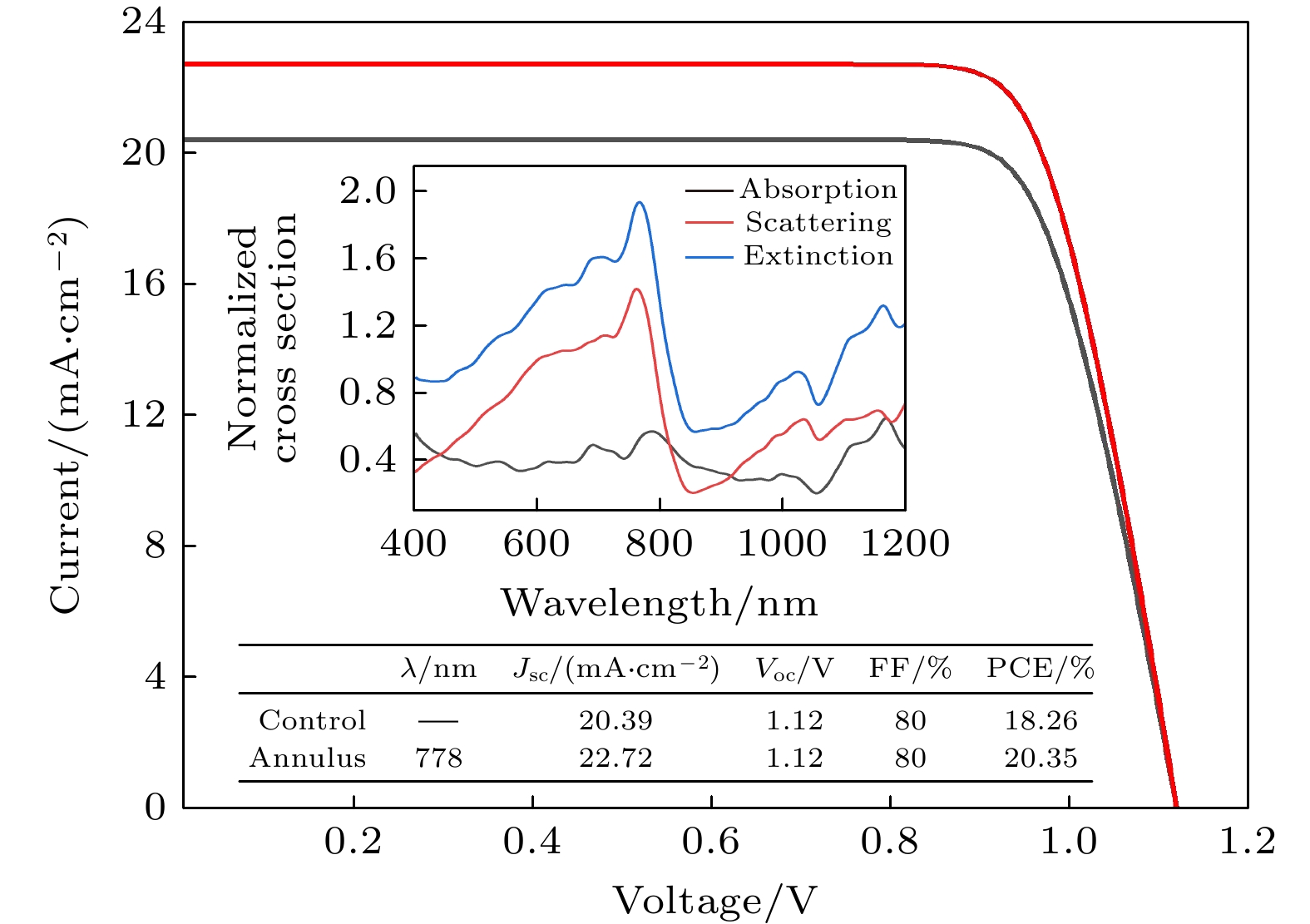
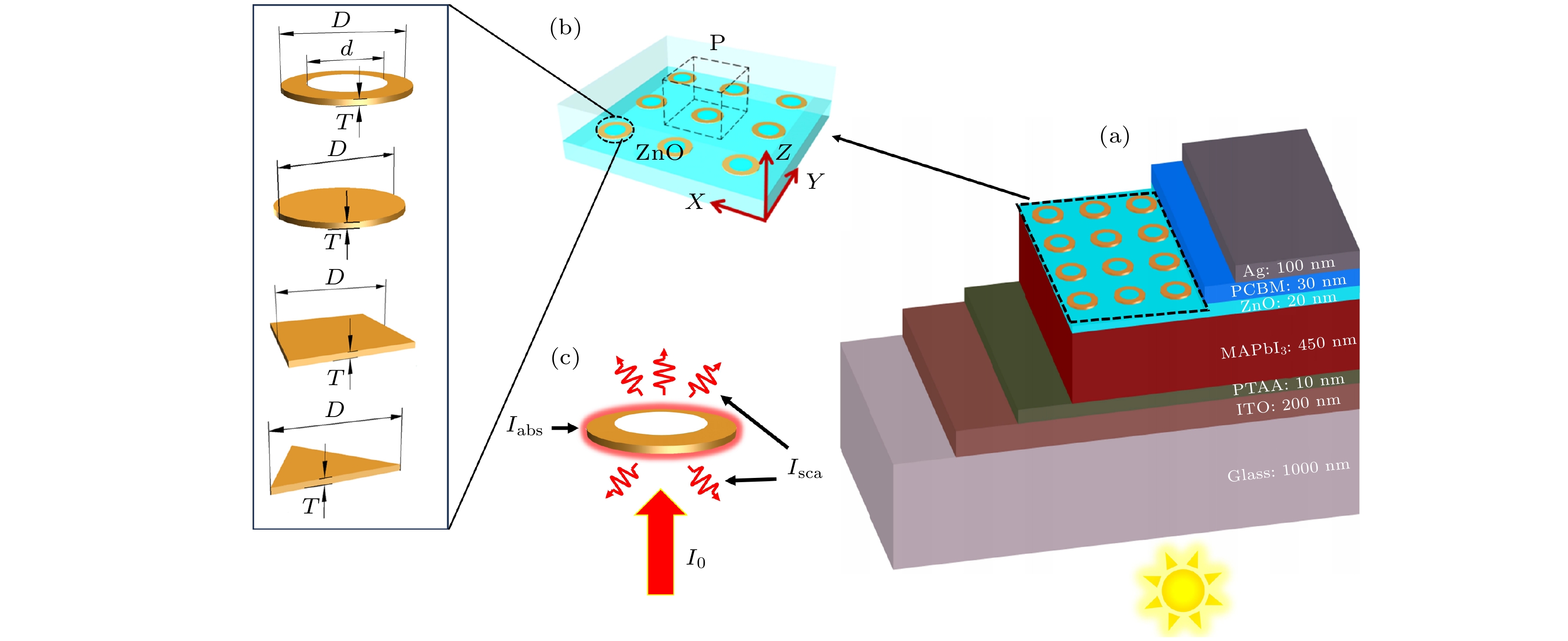
 DownLoad:
DownLoad:
